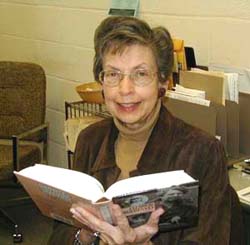| Maryland Newsline |
| Home Page |
Politics
|
| Maryland Professor Records a
First Lady's History
By
Nikki Hawkins
COLLEGE PARK, Md. - It's more than 600 pages, and yet The Eleanor Roosevelt
Encyclopedia could have been longer.
At least according to Dr. Maurine H. Beasley.
A professor of journalism at the University of Maryland,
Beasley completed the four-year task of editing some 250 entries about
the life and experiences of Eleanor Roosevelt, with co-editors Holly C. Shulman
and Henry R. Beasley. The book, published in late 2000, has already been
nominated for one award—the quinquennial Waldo G. Leland Prize given by The
American Historical Association.
“I know we will use it here,” said Raymond Teichman,
supervisory archivist for the Franklin D. Roosevelt Library in Hyde Park, N.Y.
“We get a fair number of inquiries about Mrs. Roosevelt and her life. She did
so much. No one biography or article can contain all of it. This will be a
valuable resource for many.”
As much information as there is about Eleanor Roosevelt,
Beasley said there is plenty yet to be discovered.
Roosevelt helped to bring media attention to the Red Cross
during World War II, which raised the public's awareness of the organization
founded in 1881 by Clara Barton.
Beasley said there are also original articles about Roosevelt and Herbert Hoover, as well as
on Roosevelt
and foreign policy.
“In some ways we have entries that are truly groundbreaking
in terms of Eleanor Roosevelt scholarship,” she said.
The encyclopedia examines the factual history of the former
First Lady, who served from 1933-45. It also touches on her personality and
finances.
“My husband [Henry R. Beasley] was the first to go through Eleanor
Roosevelt's tax returns,” Beasley said. “Nobody had ever really looked at [her]
tax returns before. One conclusion he reached from this is that Eleanor
Roosevelt was one of the highest-paid women of her day; but even though she
made a lot of money, she kept relatively little of it herself.
"What you can see
from Eleanor Roosevelt's expenditures and tax records is that she was quite a
generous person. She made money, but she spent it, too."
Beasley said that the NAACP and the state of Israel were
among Roosevelt's favorite causes.
But there are still some questions left unanswered, Beasley said.
The document, adopted by the U.N. General Assembly in 1948, promotes humane
and fair treatment of all people, regardless of nation. Roosevelt served as the chairman of the Human Rights
Commission during the writing of the document and served as a vocal advocate of
it.
Beasley wondered aloud about the secrets to Eleanor
Roosevelt's long and useful life. She died in 1962, at the age of 78.
“I would ask what she learned in her life. Toward the end of
her life she gave quite a few interviews and wrote some books of advice. She
liked to look back and reflect on her role and see what she had discovered
about living that she could pass on to other people. She thought that was a way
of connecting with future generations. She was always interested in young
people.”
And so is Beasley.
In researching Eleanor Roosevelt, a journalistic quest that
began more than two decades ago and resulted in the books "Eleanor Roosevelt: A
Public Quest for Self-Fulfillment," and "The White House Press Conferences of
Eleanor Roosevelt," Beasley discovered more than she expected.
“Her relationship with prominent women of that period led me
further into women’s history in many ways,” she said. “Lorena Hickock, one of
the reporters with whom Eleanor Roosevelt had a close personal relationship, is
an individual who deserves recognition in her own right as a journalist.
Through researching Eleanor Roosevelt, I discovered Lorena Hickock. I also
discovered a large group of women journalists who were members of Eleanor
Roosevelt’s Press Conference Association. Several of them would make excellent
historical studies.
"What I'm sorry about is that I don’t have enough years left
in my life to deal with all of these people in terms of academic research. But
I hope that I can get students interested."
Wanting to waste no time, Beasley, 65, has already begun her next project—the third edition of
"Taking Their Place: A Documentary History of Women and
Journalism." The first edition was released in 1977; Beasley and co-editor
Sheila J. Gibbons released the second edition in 1993.
And after this? "Eleanor Roosevelt was arguably the most important woman in
the United States and probably in the world in the middle decades of the 20th
century," Beasley said. "We’ve had some significant woman journalists, but we
certainly haven't had anybody who came close to Eleanor Roosevelt in terms of
dominating the media and lending a woman's presence to it. One could easily
write a book three times this long, and probably still not cover everything she
had a connection with or a hand in."
Perhaps another edition of The Eleanor Roosevelt
Encyclopedia may be in order.
Copyright © 2001 University of Maryland College of Journalism.
|



